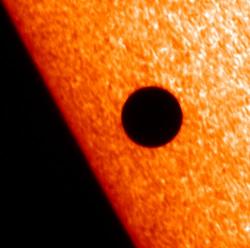The images he took in the X-ray field also revealed warm activity of the Sun that is not visible in the visible light images, although in these images the planet Hema was seen better

To estimate the power of a typical G-type star, you should look at the picture attached to this article. The tiny black dot is the planet Mercury - the planet Hema, which passed past the Sun last week.
The new Japanese satellite Hinode, renamed after its successful launch from the more conventional name Solar B, took the picture on November 8 as the planet Mercury began its passage in front of the Sun. Thousands of people on Earth saw and photographed the event, but Hinoda's photo is unlike any other because she photographed the event with a telescope operating in the X-ray frequency range.
"The Hinoda X-ray Telescope, or XRT, is the best X-ray solar telescope ever flown," said John David, a NASA scientist who also works for the Hinoda project at the Marshall Space Flight Center. "The XRT has resolutions of a minute of arc and is capable of taking an image at a speed of one per second."
X-rays are of interest to solar physicists because they reveal the hottest gas in the Sun's atmosphere. The bright curl just above Mercury, for example, is a huge mass of plasma at a temperature of thousands of degrees that makes up the sunspot. Through an ordinary telescope in the visible light range this hot mass will be almost invisible. "It's a unique picture," said Davis.
When the transit began, when Mercury moved directly in front of the Sun's surface, Hinoda also focused on it with another telescope on board - the SOT - solar telescope in the optical field. The image from that telescope shows Mercury not as a spot but as a full planetary disk.
The surface of the sun is bubbling like hot water on top of a boiling pot. Each of these "bubbles" grew as a continent on Earth.
Launched just last September, Hinoda is still in the experimental phase of its mission. Flight controllers are testing the telescopes and other systems and don't expect to begin routine science operations until mid-December. The passage of the planet Hema across the surface of the Sun is only a prelude to what is yet to come from this spacecraft.
